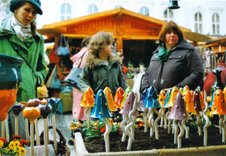
![]()
|
Index
•
|
|
Welcome
•
|
|
21st Century•
The Future |
|
World
Travel•
Destinations |
|
Reviews•
Books & Film |
|
Dreamscapes•
Original Fiction |
|
Opinion
& Lifestyle •
Politics & Living |
|
Film
Space •
Movies in depth |
|
Kid's
Books •
Reviews & stories |
|
|
|
|
The International Writers Magazine: Hungary
Nagymama (nodgey-mahmah)
• Dean Betts
They say Budapest is most beautiful at night, but it’s a tough call. I was sitting on a ledge on the west side of the Danube River overlooking it all. With the stars and the moon comes a darkness which to an extent masks the parasitic filth of the city. However, darkness synonymously somewhat obscures the conveying of Budapest’s culture and heritage; its’ tasteful mixture of architectural styles, a curious result of the country’s disrupted recent history that consequently contributes to much of the capital’s charm.
I looked along the Chain Bridge (Lánc Híd), finished in 1849, the famous stone lions guarding each end, towards the shining Parliament building on the opposite bank of Europe’s longest river. Prior to the completion of the Lánc Híd, (the first of Hungary’s eight bridges) the Danube divided the towns Buda and Pest, which in 1873 along with Óbuda were combined to form the capital city we now know to be Budapest. Upon the eventual addition of the lions to the structure in 1853, a curious child observed that the animals were without tongues. So ashamed of his mistake was the architect who was soon the subject of every joke, he became the first of many to jump from the Lánc Híd. I found myself daydreaming about the trip we had made earlier that day. My girlfriend, Erdélyi Boglárka and I had arrived in the middle of nowhere after a lot of gazing into the distance through a steady drizzle which followed the journey we had made on a few buses, for which we didn’t pay a single forint. No one seems to pay. Cutting straight through the surrounding landscape ran this one pot-holed lane which we followed earnestly for the best part of two miles once losing our wheels. The road seemed necessary only for the bus passing through to and from Budapest as there were no cars in sight. The place was completely dead.
Lop-sided old houses silently surveyed our pedestrian journey, peering out through the low fog, decorated as everything else was in the icy morning dew. The bright morning sun was unable to penetrate the harsh cold of the previous night which had left touches of frost on the tips of the visible grass, on the knobbly leafless trees and the hard soil covering the subjects of various allotments scattered here and there. Even before World War Two the inner city petite-bourgeoisie would scrimp and save in order to buy a plot of land similar to those in sight on the outskirts of the city, where they could grow fruit on their half a dozen trees and perhaps spend the holidays with their children were they wealthy enough to construct the equivalent of a summer house. The village we were navigating seemed to be the product of a community once formed on this very notion of escape from the city confines.
This was the first place I had seen under a macro lens in Hungary other than central Budapest. Geographically the country is generally very flat, owing largely to the fact that many of its hills were handed to surrounding countries in the Treaty de Versailles. As a result of this attempted ‘distribution of power and land’ by the allies after World War Two, over two million Hungarians involuntarily became Romanian citizens as an area larger than modern-day Hungary was annexed to Romania alone.
The resulting national degradation is represented in Boglárka’s family name, Erdélyi. It is a common Hungarian surname meaning ‘to come from Transylvania’ which no is longer a part of her native country. This consequently must make a patriot’s pain much sharper in the side as Transylvania often ruled separately in history from the Hungarian Kingdom by select Crown Princes, is now a Romanian province.
It would be wrong though to think that tension lives only between Hungary and its surrounding countries. In fact as much friction exists between citizens of Budapest and those Hungarians who reside outside of the capital; an area which is shrinking in size as Budapest grows ever larger, making it increasingly difficult for the country’s other cities to keep pace. Indeed, in the Hungarian language there is an indication of the divide between the inhabitants of the capital and the remaining eighty percent of the population, as the single word ‘Vídék’ describes any locations outside of Budapest. The Hungarian people consider Budapest to have removed itself from the ‘heart land’ and sold its soul to western values. This is despite the ties the city dwellers clearly feel to their rural heritage which sees attempted gardens colouring the balconies of each apartment block.
Boglárka regularly comments on the fact that most English buildings look the very much the same. This is because she has become accustomed to, for instance, approaching a crossroad in the middle of Pest and seeing four completely different buildings, one on each corner. The modern buildings and the simple, economic Soviet constructions contrast with the classicalist buildings built around the time of the Hungarian millennium of 1896 when over ten million Hungarians celebrated the 1000th year since the conquest of Hungary. It was seen then and now as the veritable embodiment of the age, the turn of the century which was self assured and successful, and an occasion for shaping the nation’s identity. Works such as Liberty Bridge (completed in 1896), the Elizabeth Bridge (1903), the Parliament building (1904) the Basilica of Saint Stephen (1905) and the Franz Liszt Music Academy, with its art nouveau Great Hall (1907) were erected in this proud era of prosperity in Hungary’s history. City Park is home to several beautiful museums including the architecturally varied Vájdahunyad Castle. Constructed out of canvas for an exhibition in 1896, then built in stone in 1904, the castle has Gothic, Romanesque, and Baroque wings.
Pest and Buda differ enormously; the latter is more residential and home to the Rósadom district which hosts beautifully elaborate houses set into Buda Hill. Tall skyscrapers exist neither side of the water, though lofty expensive hotels are springing up as Hungary heads ominously towards near complete westernization. Indeed it is hard to imagine that Hungary would not be in keeping with the almost full-scale modernity apparent in Western Europe had it not been held back by the stunting effects of Soviet rule. Unfortunately, despite the difficult nature of their past, (the struggles endured by their ancestors and the reminders dotted around them) the Hungarian people are in keeping with the will of the media moguls and advertising Gods. Such figures shaping the twenty-first century are more than willing to show their wealth through their cars and items acquired in the department stores, which are most abundant per person here than anywhere else in Europe.
Budapest lays claim to the longest escalator in Europe, and also significantly hosts the world’s second largest metro. Hero’s square is a reflection of Trafalgar square in London with its’ elaborate statues and Museum of Fine Art. Such similarities to the most popular and wealthy capitals in the world and regular examples of stubborn westernization can be found throughout Budapest. However, it is the ancient theatres, the art cinemas and the ‘avant garde’ sculptures rather than the all too familiar notions of consumerism which capture my imagination. On my first visit I was stunned by the solitary pair of stone breasts standing in the middle of a posh square and continually amazed when discovering subtle works, some without explanation like the young boy perched on the wall overlooking the river and others which further provoke the imagination such as the shoes by the water’s edge, there in memory of the Jews shot by the Nazis during World War Two.
I later visited the city of Eger where the architecture bears memories of Turkish invasions, the Turks being remembered as more fearsome enemies than even the Nazis. But on that rainy day we were on our way to visit Boglárka’s Nagymama, Hungarian for your father’s mother, the eldest of the Erdélyi bloodline. To take my mind off of the winter cold, far more intense than I am used to, I was given a little background information on the old lady I would soon meet.
At the age of seventy-nine she lives alone in a two bedroom bungalow which she was forced to share with strangers during part of the Soviet’s communist reign over Hungary due to the house not filling its living space quota; a daunting prospect. House sharing became commonplace in Hungary during the Soviet rule, after World War Two saw the destruction of many apartment blocks in Budapest and the Soviet solution, served as a way of dealing with the ‘class struggle’, enforcing social justice with regards to the communist notion of one room for one man. It was in the era after World War Two, around the time of the 1956 revolution when Imre Nagy appealed unsuccessfully to the powers of the West to recognise Hungary as a neutral country, that simple apartment blocks began to arise as the Soviets sought an economic way to accommodate the citizens overpopulating the capital. Nagymama has been somewhat separated from the inner city struggles of Budapest as she lives still in the same house in which she was born, though that is not to say that as most ageing Hungarian citizens have, she has pulled through some incredibly trying times. She is the mother of twin boys named Sándor (Shaan-door) and Imi; Sándor after their father, Imi, not. The people in the village took a strong dislike to their mother, reproving in the event of their birth as at that time it was believed that she must have slept with two men in order to have twins; regardless of the fact that they were identical! She divorced her husband when drinking became his primary hobby, and so struggled alone with two troublesome young boys.
Her older brother was the victim of a drive by shooting on a playground during the war when he was only fourteen. He was an accomplished violinist whose instrument was handed down to Boglárka. Whenever she would play, Nagymama would cry… before it was stolen that is. The old woman’s parents died when she was around the age of seventeen.
We drew closer, passed through the creaking, crumbling gate and up the garden path. The tension of mentally preparing to give the customary kiss on each aged, sagging cheek without clashing heads or otherwise injuring the recipient, (I’ve gotten much better at this now) augmented to something stupendous. The respect I felt was raw and the nerves it instilled could only be fought by concentrating on the thought of the imminent consumption of delicious, traditional Hungarian food.
She wasn’t the iron nosed witch, common in Hungarian folk tales that one expects to meet when heading to the house of an ancient woman. The meal we ate consisting of the ever popular paprika pork accompanied by tarhonya, egg pasta used centuries ago by Hungarian nomads travelling the plains due to its ability to keep for long periods was better than could ever have been predicted. Though I was unable to understand a word the old lady said and had every question, trivial or probing translated by Boglárka, I felt pronouncedly at home amongst the photo albums.
There was one fleeting, uneasy moment when Boglárka left the room. Her Grandmother tried to suggest with body language that I might need to undo my top button in order to stomach the food she was insistently piling onto my plate in true Hungarian fashion. I foolishly interpreted this as her willing me to take off my jeans, something which I was not too enthusiastic about. Luckily my translator returned before I could make a complete idiot of myself and we three laughed it right off. I felt at peace once more, and observing the eerie empty table place which was set next to me out of tradition in case of an unexpected visitor, I hoped sincerely, possibly naively, that Hungary would survive the western influences and remain in touch with it’ customs, which make the country such an attractive place to spend any spare moment one can seize.

© Dean Betts March 2008
orionsbelt_1@hotmail.com
Dean is a Creative writing major at the University of Portsmouth
More Destinations
Home© Hackwriters 1999-2008
all rights reserved - all comments are the writers' own responsibiltiy - no liability accepted by hackwriters.com or affiliates.





